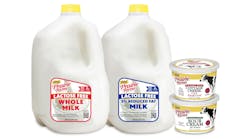The anticipated impact of nanotechnology upon society is frequently referred to as the “second industrial revolution.” Rapid advances in nanotechnology promise to revolutionize many of the ways we manufacture products, produce energy, diagnose and treat diseases and increase global food production.
The current number of food products using nanotechnology of any sort is relatively small. Nevertheless, hundreds of research projects are under way and tens of millions of dollars are being spent in a global race to apply nanotechnologies in food production, processing and packaging.
When will this research result in significant numbers of nanotech food products appearing on supermarket shelves? What are the potential benefits and risks? How can the food processing industry ensure consumer confidence and acceptance of nanofoods? Given the recent history of public concerns and missteps involving genetically engineered food, the introduction of any new technology into food products offers significant challenges for both government and industry.
A canola oil contains tiny nano-particles that block cholesterol from entering the bloodstream. A chocolate shake is tastier and more nutritious thanks to the addition of nano-sized ingredients 100,000 times smaller than a grain of sand. Food packages are embedded with nano-particles that alert consumers when a product is no longer safe to eat. Nanomaterials enhance the biological activity of dietary supplements or nutraceuticals by allowing delivery of nutrients directly into cells.
These are all examples of currently available food innovations made possible by nanotechnology, using breakthroughs in the manipulation of matter at the molecular level. Experts estimate nanotechnology will be incorporated into $20 billion worth of consumer food products by 2010 as the world’s largest food companies use the super small to make big improvements in food packaging, safety and nutrition. At this moment there are hundreds of new nanofood product projects under way with many likely to be on store shelves within a year.
Is there any reason for concern? Consumers and others -- such as workers in the agricultural and food processing industries, who might come into contact with nano-materials -- have a right to know what they are being exposed to, as well as the risks of the exposure. Surprisingly, the answer to that question is largely unknown. The commercialization of nanotechnology has rapidly outpaced the research to address possible human health or environmental risks.
Governmental oversight bodies are still far behind the curve in developing and conducting research and regulatory strategies. An analysis of research done by the Project on Emerging Nanotechnologies, for example, found no research on the impact of nano-materials on the gastrointestinal tract, although this will be of significant concern for food applications.
There is no authoritative accounting of nanofood products and their associated potential risks and benefits. For that reason no one really knows what to expect in the next few years: 50 products? 500? 1,500? And what of the risks? One of the problems with accurately estimating nanotechnology innovations is food and beverage companies (and their suppliers) may be wary to apply the nanotechnology label to a new product, aware that a significant segment of the public does not want its food “engineered” -- bio, nano, or otherwise.
It was not long ago that advances in genetic science were supposed to transform the food production industry by offering safer, higher-yield production methods and more nutritious foods – the same benefits being touted for nanotechnology. But the industry’s tendency with genetically modified food -- to commercialize first and respond to consumer concerns later -- proved to be a major problem. A failure to thoroughly explore potential risks and to openly and candidly discuss them with the public resulted in several controversies that resulted in great harm to the food industry even where the actual problems posed little, if any, real threat.
Even where there are recognized benefits for consumers, the risk/benefit tradeoff of nanotechnology may not be as clear for food and agriculture products as it will be for other products, such as life-saving drugs and medical devices. Consumers have a low risk tolerance when it comes to the food they eat and serve to their children.
The stakes are very high for the food processing industry to get it right the first time with nanotechnology by moving aggressively to identify and address health and environmental concerns of nanotechnology applications before products reach the market. One already hears government officials and consumer groups voicing many of the same opinions and concerns about nanotechnology as they did with the genetically engineered foods. By applying those lessons learned, the food industry can reap tremendous returns on the large investments now being made in nanotechnology. More importantly, that success will ensure that consumers and society generally benefit from the significant promise shown by nanotechnology applications in food production.
Ronald Wernette is a partner with the law firm of Bowman and Brooke LLP, where he focuses on defending product liability and other exposure litigation, including the impact of nanotechnology applications in food processing, agriculture, biotechnology and medical devices. He can be reached at [email protected], or see www.bowman-brooke.com.

